Something CTIA and Wi-Fi Community Might Agree On

These days CTIA and the Wi-Fi community don't seem to agree on much due to the ongoing LTE-U/Wi-Fi controversy. But here is something that they are both likely to agree on for this weekend: Let's hope that FCC's total abdication of interest or responsibility for any aspect of drone spectrum issues does not result in spectrum chaos this weekend in the cellular bands and/or Wi-Fi bands, but possibly other bands if the drones marketed in the US are as noncompliant with spectrum emission rules as the drones marketed in Europe.
Readers may recall that we reported 10 days ago on the EU study shown at right that found high EMC noncompliance rates in the European market. Do you think Asian manufacturers are more careful with models destined for USA because they fear FCC enforcement?
This EU report observed what has been previously discussed here about the interference potential of drones that are not properly regulated:
So let's hope that the huge number of new drones that will be airborne this weekend do not result in spectrum chaos due to their location at altitudes that were not expected by cellular planners and Wi-Fi users or from out-of-band emissions. And let's hope that if they do cause interference that FCC will respond more quickly and decisively than it did in the case of "cellular boosters", police radar detector interference to VSATs, or the ongoing FM harmonic interference to 700 MHz LTE base stations - which FCC has never made a public pronouncement on.Signals transmitted from the air to the ground have a significantly bigger coverage area than from the ground. Therefore, interferences generated from RPAS could have a major impact on radio communication. This means that there is a higher risk of harmful interference if RPAS systems do not meet the essential requirements.
Perhaps serendipity might save the spectrum community this time from chaos. But really, is this the way to protect multibillion dollar industries that are deeply tied to our society and economy? Should we have an FCC that can pay attention to issues other than corporate merger review and finding more spectrum for cellular carriers?
After the holidays, readers might want to review my TPRC paper this year that deals with FCC productivity shortfalls in spectrum policy and argues that they result from BOTH resource shortages and an inability for the FCC's "8th Floor" to understand they have to delegate some issues more in order to keep up to the magnitude of their job in today's IT focused world. (General Motors board of directors does not review every design detail of next year's Chevy because they could not keep up with their strategic responsibility if they did. FCC's commissioners need to develop a more collegial relationship and decide which issues are "bottom line" for they and need limited availability en banc deliberations and which can be left to staff under agreed guidelines like Ofcom has with its staff.)
And let's all pray we avoid spectrum chaos this weekend. Best wishes to all for a happy holiday season!
EU Market Surveillance Finds High EMC Noncompliance from Present Consumer Drones
- Drones and their use of spectrum
- Enforcement of FCC equipment authorization rules
Every year the EU pick a type of radio equipment for market surveillance to see if actual units are complying with the EU counterparts to FCC equipment authorization rules give in Part 2, Subpart J of FCC's Rules. This year 16 countries (Austria, Estonia, Finland, France, Germany, Greece, Lithuania, Luxembourg, the Netherlands, Norway, Poland, Slovakia, Spain, Sweden, Switzerland and the United Kingdom) cooperatively examined 79 drone models sold in EU territory. 92% of the units tested "were manufactured in countries of the Far East ". The mean price of systems was "between 100 and 200 euro". These units almost all used the 2.4 and 5.8 GHz unlicensed bands, best known for Wi-Fi.
The report observed what has been previously discussed here about the interference potential of drones that are not properly regulated:
Signals transmitted from the air to the ground have a significantly bigger coverage area than from the ground. Therefore, interferences generated from RPAS could have a major impact on radio communication. This means that there is a higher risk of harmful interference if RPAS systems do not meet the essential requirements.
Here is what the EU found about compliance:
The market surveillance authorities found that ninety two percent (92%) of the devices did not fulfil all of the requirements. Half (51%) of assessed RPAS were found to be non-compliant in relation to the effective use of spectrum. Four out of five (82%) had administrative non-compliances within the meaning of the R&TTE Directive.
The campaign showed that the main reasons for non-compliances with the effective use of spectrum were spurious emissions (70%) and radiated power/power density (23%). Furthermore, the figures show that the remote controls on the ground tend to have a higher non-compliance rate than the aircraft systems.
The market surveillance authorities consider the rate of non-compliances too high. The growing market of remotely piloted aircraft systems combined with a low compliance rate could lead to an increase of interferences to the radio spectrum. Market surveillance authorities should therefore continue to check at national level such products and take all appropriate measures to ban non-compliant products from the market. Regular reporting in ADCO R&TTE is recommended.
It is reasonable to assume that most of the models sold in the EU are also sold in the US and that if they don't comply with EU regulations they probably don't comply with FCC ones either. The FCC counterpart of "market surveillance" was reviewed in Docket 13-44 and the rules were tightened in its Report & Order. But it appears that the EU approach is more transparent with eh issuance of reports like that shown above. It also appears that there is central planning of equipment categories to surveil whereas in the US Telecommunications Certification Bodies (TCBs) due surveillance on behalf of FCC and have great discretion in their actions. There is also a conflict here in that TCBs have a supplier relationship to manufacturers/importers who buy their services.
So several questions come from reviewing this EU report:
- Are drones now sold in the US as noncompliant as the ones sold in Europe?
- If so, why haven't the TCBs or the FCC noticed it?
- Does the allegedly overactive Enforcement Bureau have any interest in this matter?
- Will the Wi-Fi community get distracted enough from it present focus on LTE-U issues and recognize this serious threat to its spectrum?
A Top FCC Officals Mentions "Drone"!
Hello, Reno! Look forward to talking fiber, wireless, drones, startups in the Biggest Little City in the World. pic.twitter.com/kcx0OR9DU1
— Ajit Pai (@AjitPaiFCC) September 11, 2015
- A July 1, 2010 letter from Chmn. Genachowski to Rep. Waxman mention drones several times, but all in the context of questions on whether AWS-3 spectrum transfers would affect DoD's use of drones in CONUS.
- A March 13, 2014 speech by Comm. Clyburn mentions that the then pending "Drone Aircraft Privacy and Transparency Act would limit the use of drones in U.S. airspace". This bill from Rep. Markey has not passed the House.
- The April 27, 2015 Report and Order in ET Docket No. 12-338 states that in the 4400-4940 MHz band "Typical Federal uses include, but are not limited to, point-to-point microwave, drone vehicle control, and telemetry" and makes no mention of civil drones.
- Comm. O'Rielly's April 28, 2015 PCIA speech mentions possible new types of cellular infrastructure says "Some people have suggested such ideas as a series of balloons, solar-powered drones, or small satellites."
It is frankly puzzling given how much discussion there is everywhere in DC about drones that FCC has so little interest in the topic.
Drones need airspace, regulated by FAA. Drones also need spectrum, regulated by FCC.
Drones compete for that spectrum with other incumbent of future users.
Some drone use of spectrum may be too burdensome for other users.
Some bands may be perfectly appropriate for drones use.
How is this ever going to be resolved considering FCC's apathy for this topic?
UPDATE
Comm. Pai apparently is on a roll with the drone issue as his 8th Floor colleagues and the FCC staff continue their deafening silence that drones on.
Perhaps this is confirmation of your blogger's hypothesis that there is a real throughput shortfall in FCC's present process and resources for resolving spectrum policy issues and, like Donald Trump, the incentive auction has "sucked all the oxygen out of the room".
The September 17th tweet below is his second public mention of "drone" in less than a week, setting a new record for any FCC official! Perhaps he didn't get the memo that any FCC mention of this topic is forbidden?
Now can one of the FCC commissioners take a similar interest in millimeter wave technology and FCC's apparent "War on Millimeterwaves"?
Grateful to @unevadareno UAV team for stimulating discussion re technology/regulation of drones. Much to think about. pic.twitter.com/pOvxIlvKEb
— Ajit Pai (@AjitPaiFCC) September 17, 2015Japan's Abe’s robot panel aims to give drone industry an edge
Note the proposed synergy of aeronautical regulations and spectrum regulations.
Prime Minister Shinzo Abe speaks during the party's annual convention in Tokyo on Sunday. The Robot Revolution Realization Committee, an advisory panel appointed by Abe, will review existing radio and civil aeronautics laws and set up industry-run best practices for drones. | BLOOMBERG
Abe’s robot panel aims to give drone industry an edge
Reuters
The Abe administration is looking to fast-track industry-friendly regulation to give Japan’s drone sector an edge over the United States.
…
The Robot Revolution Realization Committee, an advisory panel appointed by Abe, will review existing radio and civil aeronautics laws and set up industry-run best practices for drones.Another panel is asking companies for ideas on how to open up new special economic zones in Tokyo and other big cities to drones on a test basis
…
.We want to keep an eye on the world’s drone market, starting with the United States, and consider Japan’s way of doing things,” said Tamotsu Nomakuchi, who heads the robot panel. “It’s not about copying other markets, but learning about them and creating something better.”
While FCC’s and NTIA’s silence on drone spectrum drones on, Japan Inc. is trying to get its act together for economic growth! Hey, isn’t NTIA part of the Commerce Department?
While inside sources mention ongoing discussions between FAA and FCC on drone issues, there is no public acknowledgment that such discussions have even occurred.
This issue is not just providing spectrum for drone use, it also involved deciding which spectrum is inappropriate for drone use. This may well include both cellular and Wi-Fi spectrum for various reasons such as limiting the impact of drone use at high altitudes on terrestrial users.
While the Commission and its staff are paralyzed over the “NN issue”, this important issue is getting no visible attention.
Maybe the specter of Japanese initiative might strike fear in some circles now and spur the FCC to end its inaction.
Title III called and is demanding some attention now!
As Positive Uses of Drones Appear, FCC Still Too Distracted to Look at Spectrum Issues
Drones and spectrum have been a recurring topic in this blog. But there is no visible action from FCC on any aspect of this problem although insiders have told your blogger that it has been discussed at high levels in FCC. Comm. Clyburn mentioned pending drone legislation in a March 2014 speech, but that is the most visible action that has been public.
The fundamental problem here is that FCC, in your blogger’s opinion, has a fundamental gap between its throughput capacity for making spectrum policy decisions and the workload before it. Part of this is that the structure of decision making at FCC may be inappropriate for many technical decisions that are not fundamentally political. Regardless of the cause, FCC is continuing to fall behind in its workload as it struggles with the megaissues before it: incentive auctions, net neutrality, and corporate mergers.
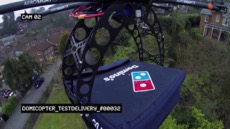
But while Congress has told FAA to act on drone issues by next year, FCC is part of the issue also and seems to be ignoring the issue of spectrum access by drones and whether access ins one bands, e.g. Wi-Fi and cell phone bands, might cause negative impacts. Sources in the cellular industry have confirms to be concerns about drones using cellular spectrum for smart phones at heights of 100-200m, but the industry is reluctant to raise any new issue before FCC that might distract from the spectrum auction. Another sign of the present decision making throughput shortfall.
UPDATE
Here is an article about a drone being sold by Amazon for a one day sale price of under $60 that uses “spread spectrum” in the 2.4 GHz ISM band, home of most Wi-Fi systems. While this one appears to have limited altitude capability, Wi-Fi users might want to contemplate the pfd footprint of a similar device at 100m or higher, not to mention the specter of Wi-Fi jamming from those concerned about “peeping drones”.
Beginning of Wi-Fi Privacy-Related Electronic Warfare
In a previous post we wrote about the jamming threat to Wi-Fi and cellular that may come from unrestricted access by private drones to their spectrum. Today, a CNN post provocatively entitled “This gadget can knock drones and Google Glass offline” describes a device called the “Cyborg Unplug”. Its maker describes it as
Cyborg Unplug is a wireless anti-surveillance system for the home and workplace. 'Plug to Unplug', it detects and kicks devices known to pose a risk to personal privacy from your local wireless network, breaking uploads and streams. Detected devices currently include: Google Glass, Dropcam, small drones/copters, wireless 'spy' microphones and various other network-dependent surveillance devices.
Cyborg Unplug comes hot on the heels of glasshole.sh, a script written by Julian Oliver to detect and disconnect Google's Glass device from a locally owned and administered network. Following broad coverage in the press, the script struck a chord with countless people all over the world that felt either frustrated or threatened by the growing use and abuse of covert, camera-enabled computer technology.
Whether business office, restaurant, school or nightclub: it's your territory and your rules, so make it harder for those that seek to abuse it.
The maker describes the 2 modes of the device:
Cyborg Unplug can be operated in two modes. The recommended mode is Territory Mode, disconnecting target devices from selected network(s) owned and operated by the user. The other mode is All Out Mode, which disconnects all detected target devices from any network they are associated with, including paired connections with smartphones. Please note that this latter mode may not be legal within your jurisdiction. We take no responsibility for the trouble you get yourself into if you choose to deploy your Cyborg Unplug in this mode.
We will not parse here US rules and regulations about whether this is illegal. Nor will we speculate on whether it will actually work as advertised. This new product and its website and PR campaign shows the pent up demand for privacy protecting devices. If this device becomes popular, explicitly illegal Wi-Fi jammer manufacturers probably will go after the same market and a whole cycle of electronic warfare will begin.
The Wi-Fi industry and cellular industry should do some soul searching about whether their nonchalant attitude towards privacy invading uses of their technology contributes to supply and demand issues for jammer-like devices. Your blogger was once involved in electronic warfare issues decades ago. He does not want these to come to the dynamic civil communications systems that contribute so much to our society and economy.
Once Pandora’s Box is fully open, large NALs to mysterious Chinese companies will really have no impact.
Leaders of the Wi-Fi and cellular industries: Are there actions your industries are taking or trends which you are ignoring that are stimulating the demand for jammers? Will addressing these issue within your industries be more effective than relying on the currently underfunded FCC to solve severe problems that are likely beyond its resources if they take hold?
Drones & Spectrum:•Will FCC Policy Vacuum Trigger Jamming Increase?
•Will Propagation from Altitude Overload Already Crowded Spectrum?
•Will Propagation from Altitude Overload Already Crowded Spectrum?
Seattle Woman Spooked by Drone Outside Her Window
The GPS and cellular industry are vehemently against jamming of their spectrum and are pressing FCC for more rigorous action. The recent June 20 FCC workshop on “GPS Protection and Receiver Performance” was full of pledges to step up enforcement and the recent $34,912,500 NAL to a Chinese jammer manufacturer was an attempt by FCC to show its commitment to such enforcement - although the likelihood of the perpetrator ever paying anything is slight.
From an actual jammer ad
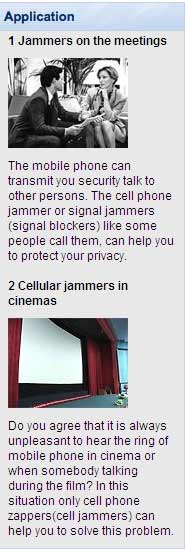
The picture at left comes from a cellular jammer ad and shows the pitch they are using. (We will not give the original source here but it has been shared with FCC/EB.)
While FAA is working under a congressional mandate to resolve its regulations for drones, FCC seems disinterested in the matter -- except in the context of the NPSTC National 4.9 GHz Plan for public safety users. But as the NY Times reported yesterday “Drones Outpacing Rules as Popularity Soars in New York”.
Using either cellular spectrum or unlicensed spectrum from drones is really a bad idea and should be forbidden.
Why? There are good technical reasons why we have frequency allocations for the Aeronautical Mobile Service where drone-related communication should be. The range of a radio signal (and its potential interference to other users) is determined both by its transmitter’s height as well as its (effective radiated) power. Airplanes and drones are at much higher heights than terrestrial users.
The unlicensed and cellular bands and their technical rules were designed for terrestrial use. Using cellular or unlicensed spectrum at even several hundred foot altitude will impact other users much more than comparable terrestrial use. For example, in a dense cellular repeater environment, a drone-based cellphone will likely hit several repeaters with comparable power and use up disproportionate spectrum capacity. Similarly, it will disproportionately increase the apparent load in unlicensed systems, effectively decreasing their capacity much more than a terrestrial user with the same bit rate.
In addition to this overload problem, drone based imagery will likely be seen by many as invasive as shown in the video at the top of this post. Experience has shown that such feelings often lead to interest in jamming for self-protection. While such jamming is illegal, it is growing and FCC actions to date under present laws and rules have had little impact. Thus it is likely that the growth of drone-based imagery in the unlicensed bands and cellular bands will be accompanied by a surge of jamming to the detriment of all cellular and unlicensed users!
So why isn’t anything being done? Look back a few blog entries to the “VA and FCC” entry here. Your blogger believes that like the VA, FCC is operating at a throughput less than that required for its actual spectrum policy role. In this hypothesis, major regulatees, both licensed and unlicensed, are implicitly or explicitly told to limit their requests to FCC so they can at least get their key requests accomplished.
What could be done about drones at FCC to prevent drone based downlinks from adversely impacting unlicensed systems and cellular systems? The previous drone post here advocated amending § 15.9 to forbid drone based imagery as well as the currently forbidden (for non law enforcement) “eavesdropping”. With respect to cellular systems, both § 22.925 and § 91.21 limit use of transmitters in "1) Aircraft operated by a holder of an air carrier operating certificate or an operating certificate; or (2) Any other aircraft while it is operated under IFR" and "aboard airplanes, balloons or any other type of aircraft". We urge FCC to amend these to forbid use of cellular spectrum from drones and urge the cellular community to tell FCC this is an urgent matter.
Note that we are not advocating that FCC forbid spectrum for drones, rather that such spectrum use be in bands that are planned for such use considering the heights involved in it.
Sprint’s New Drone
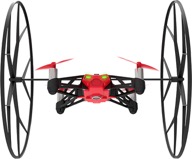
Review of a Consumer Drone Using 2.4 and 5 GHz Unlicensed Spectrum
FCC §15.9, Drones & Privacy
§ 15.9 Prohibition against eavesdropping.
Except for the operations of law enforcement officers conducted under lawful authority, no person shall use, either directly or indirectly, a device operated pursuant to the provisions of this part for the purpose of overhearing or recording the private conversations of others unless such use is authorized by all of the parties engaging in the conversation.
The above is the current text of 47 C.F.R. 15.9 that limits the use of unlicensed devices for “eavesdropping”. Not being a subscriber to WestLaw or Lexis, I can’t readily tell you how long this language has been in the FCC Rules, but I am pretty sure it predates my arrival at FCC in 1979. This section not only limits the use of unlicensed devices for eavesdropping, but also gives the FCC an excuse to deny equipment authorization to them and thus to keep them off the open market.
The possibly widespread use of drones raises all sorts of privacy concerns. While your blogger is a “card carrying ACLU member”, something that really annoyed FBI and other intelligence community employees he interacted with while at FCC, this post does not deal with surveillance that is explicitly authorized by law. Rather it deals with surveillance for commercial purposes or just invading the privacy of your neighbors. (Federal operation of drones is not subject to any FCC jurisdiction in any case, although state and local police use is.)
A simple first step FCC could take would be to extend the long-standing provisions of §15.9 to include imagery from drones, thus keeping cheap unlicensed drones out of Radio Shack and large scale consumer use. If you want to get imagery from drones, the least you can do is get a radio license.
Part of a cellphone jammer ad

From a Wi-Fi Jammer Ad
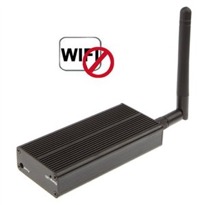
UPDATE
This CNN piece about drones tricking Wi-Fi to get your private information in a “man in the middle attack” may be another reason to limit drone access to unlicensed bands.
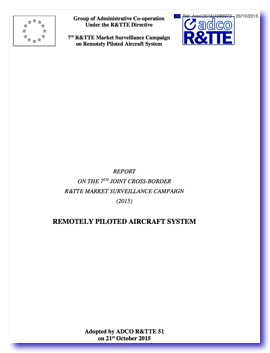





![Validate my RSS feed [Valid RSS]](valid-rss-rogers.png)

